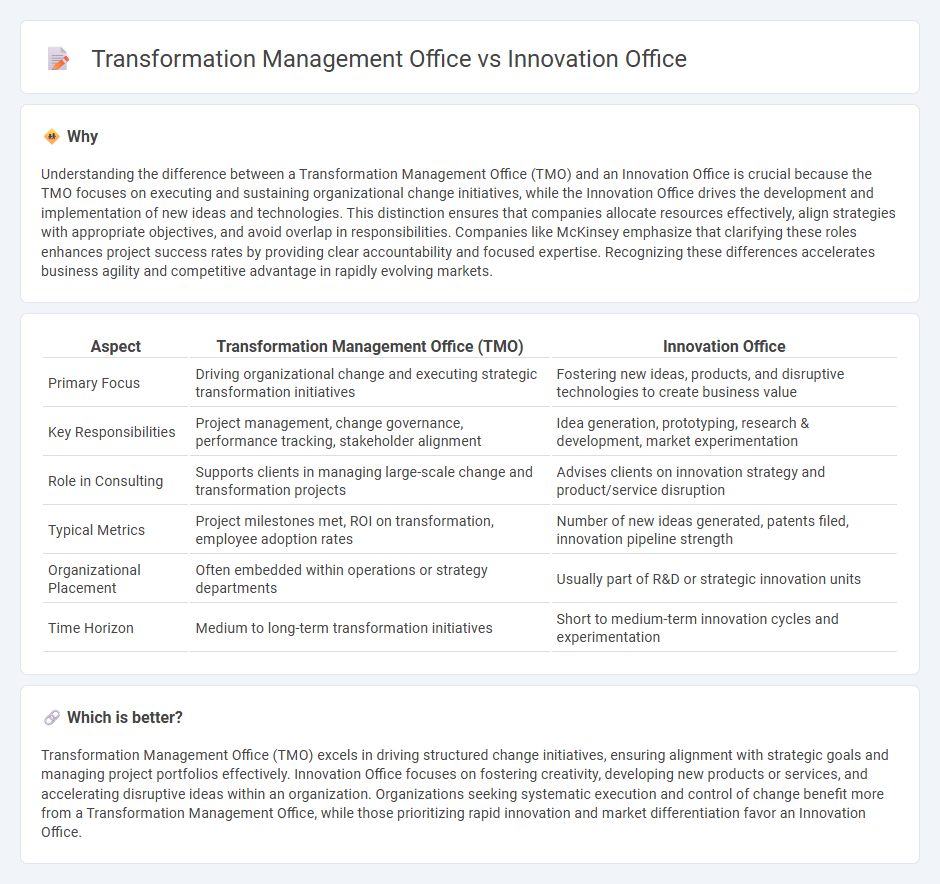
Transformation Management Office focuses on overseeing and driving organizational change initiatives to improve operational efficiency and achieve strategic goals. Innovation Office emphasizes fostering creativity, developing new products, and implementing cutting-edge technologies to maintain competitive advantage. Explore how each office uniquely contributes to business growth and adaptability.
Why it is important
Understanding the difference between a Transformation Management Office (TMO) and an Innovation Office is crucial because the TMO focuses on executing and sustaining organizational change initiatives, while the Innovation Office drives the development and implementation of new ideas and technologies. This distinction ensures that companies allocate resources effectively, align strategies with appropriate objectives, and avoid overlap in responsibilities. Companies like McKinsey emphasize that clarifying these roles enhances project success rates by providing clear accountability and focused expertise. Recognizing these differences accelerates business agility and competitive advantage in rapidly evolving markets.
Comparison Table
| Aspect | Transformation Management Office (TMO) | Innovation Office |
|---|---|---|
| Primary Focus | Driving organizational change and executing strategic transformation initiatives | Fostering new ideas, products, and disruptive technologies to create business value |
| Key Responsibilities | Project management, change governance, performance tracking, stakeholder alignment | Idea generation, prototyping, research & development, market experimentation |
| Role in Consulting | Supports clients in managing large-scale change and transformation projects | Advises clients on innovation strategy and product/service disruption |
| Typical Metrics | Project milestones met, ROI on transformation, employee adoption rates | Number of new ideas generated, patents filed, innovation pipeline strength |
| Organizational Placement | Often embedded within operations or strategy departments | Usually part of R&D or strategic innovation units |
| Time Horizon | Medium to long-term transformation initiatives | Short to medium-term innovation cycles and experimentation |
Which is better?
Transformation Management Office (TMO) excels in driving structured change initiatives, ensuring alignment with strategic goals and managing project portfolios effectively. Innovation Office focuses on fostering creativity, developing new products or services, and accelerating disruptive ideas within an organization. Organizations seeking systematic execution and control of change benefit more from a Transformation Management Office, while those prioritizing rapid innovation and market differentiation favor an Innovation Office.
Connection
The Transformation Management Office (TMO) and Innovation Office collaborate to drive organizational change by aligning strategic initiatives with cutting-edge innovation processes. The TMO oversees project execution and change management, ensuring that innovation efforts lead to measurable business outcomes and seamless adoption. Integrating innovation frameworks within the TMO accelerates transformation success by fostering a culture of continuous improvement and adaptive growth.
Key Terms
Disruption
Innovation Offices prioritize identifying and leveraging disruptive technologies to foster groundbreaking products and services that reshape market dynamics. Transformation Management Offices concentrate on executing strategic change initiatives that drive organizational agility and process optimization to sustain competitive advantage. Explore how integrating both approaches can accelerate disruptive innovation and effective transformation in your business.
Change Management
The Innovation Office drives the adoption of new ideas and technologies to foster organizational growth, whereas the Transformation Management Office (TMO) concentrates on overseeing large-scale change initiatives and ensuring strategic alignment. Change Management within the TMO involves structured processes to manage resistance, communicate effectively, and sustain change across all business units, emphasizing clear milestones and stakeholder engagement. Explore the critical differences and synergies between these offices to optimize your organizational change strategy.
Governance
Innovation Offices drive ideation and pilot projects by fostering creativity within a defined governance framework prioritizing agility and experimentation. Transformation Management Offices oversee organizational change through structured governance, ensuring alignment with strategic objectives, risk management, and resource allocation. Discover how robust governance models differentiate these offices to maximize innovation and transformation success.
Source and External Links
Office of Investment and Innovation | U.S. Small Business Administration - The SBA's Office of Investment and Innovation supports growth-oriented small businesses and startups by providing access to capital, assistance, and networks, delivered through three divisions focused on investments, technological innovation, and ecosystem development.
Project Accelerator Transition Innovation Office (PATIO) - ARPA-H - PATIO helps translate scientific breakthroughs into products by supporting ARPA-H projects with commercialization strategies, market adoption, and regulatory guidance to ensure successful technology transition.
MSU Innovation Center - MSU's Hub for Corporate Partnerships - Michigan State University's Innovation Center fosters partnerships to translate research and faculty innovations into real-world products through engagement, tech transfer, and entrepreneurship support.
 dowidth.com
dowidth.com